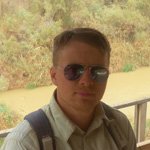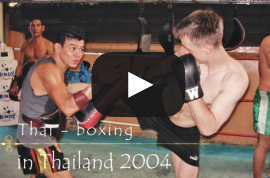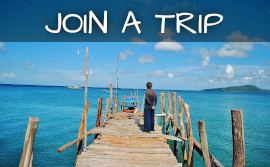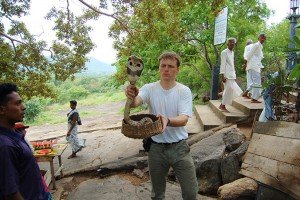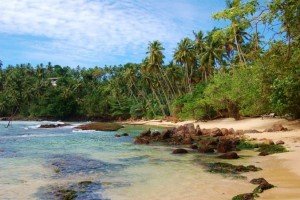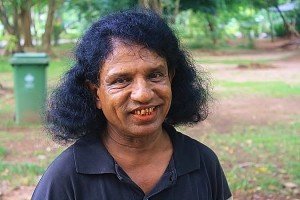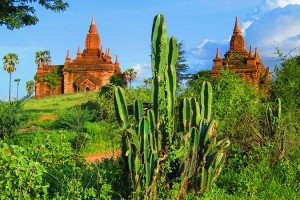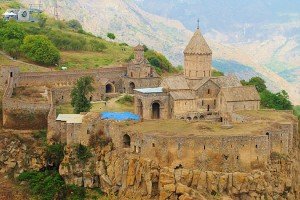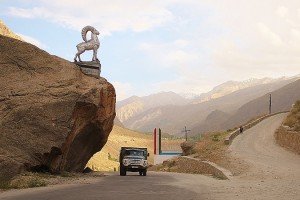Saudi Arabia … and passion for travel
Saudi Arabia … and passion for travel
Saudi Arabia is a new and unknown tourist destination, which from the beginning of its existence was closed to followers of religions other than Islam. Saudia has been open to visitors from outside the Islamic world only since 2019, so to the vast majority it is still a country shrouded in mystery and stereotypes. I believe that this kind of approach is understandable in this case, and it was one of the reasons why I decided to get to know this country thoroughly.
Introduction to travelling around Saudi Arabia
I divided my trip around Saudi Arabia into four main zones, which were: South of Jeddah, North of Jeddah, Riyadh and the surrounding area, and the Eastern Province due to the fact that I also planned to go to Bahrain. When in Saudi I visited many places that were exceptionally beautiful from the natural side as well as places of historical and cultural value. The desert and herds of camels between those places were of course also a great adventure. I stopped many times in the desert to have contact with camels.
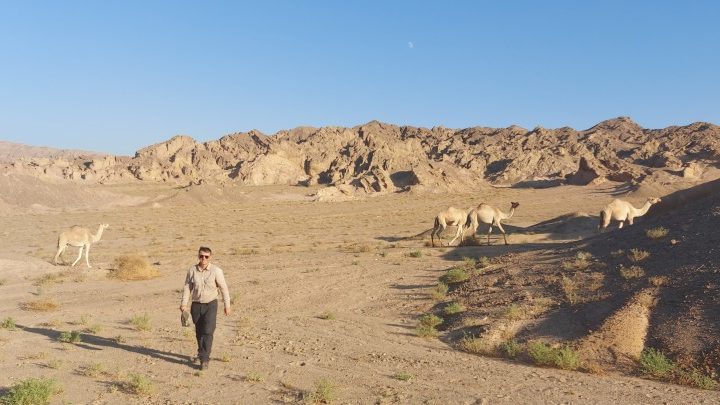
My expedition through Saudi Arabia was a great epic adventure. Here I stopped in the desert to have contact with camels, heading north towards the Jordanian border.
In this article it is not my goal to list all the places I saw, because that is what travel journals are for. Here I would like to mention just some of them, to encourage my readers to visit Saudi Arabia. This article can be treated as an introduction to the trip around Saudi, and I consider myself an experienced traveller because I spent over seven weeks in Saudi, travelling to all its corners.
Truth is possible only through personal knowledge of countries, while knowledge through the prism of the media will always be a lie aimed at shaping public opinion in order to control the masses.
Saudi Arabia – are the stereotypes true?
Typically stereotypes have rational basis, although they are also sometimes prone to exaggeration. Whilst traveling around Saudi Arabia Arabs complained to me about how their country is perceived in the West. They said that: ‘according to Europeans and Americans in Saudi Arabia there are only: ‘desert, camels, Islam and oil’. Besides, the world thinks that apart from those things there is nothing in Saudi at all.
I explained that those in Europe who are interested in Arabia at least partially treat this opinion as a joke, although on the other hand it cannot be hidden that it is largely true. Indeed, when traveling around Saudi Arabia the landscape was mostly monotonous because desert was everywhere. Whilst travelling around Saudia and looking out the window Arabs sometimes said to me: ‘your country is green and we only have desert’. Therefore indeed Saudia is a hot desert country where live greenery is rare and difficult to maintain. One of the symbols of the Arab world, not only of Saudi Arabia, are camels. I said that it’s good that in Europe they think so because everyone likes camels. As for crude oil Saudia is its largest producer and exporter. I also saw oil fields in the Saudi desert a few times.
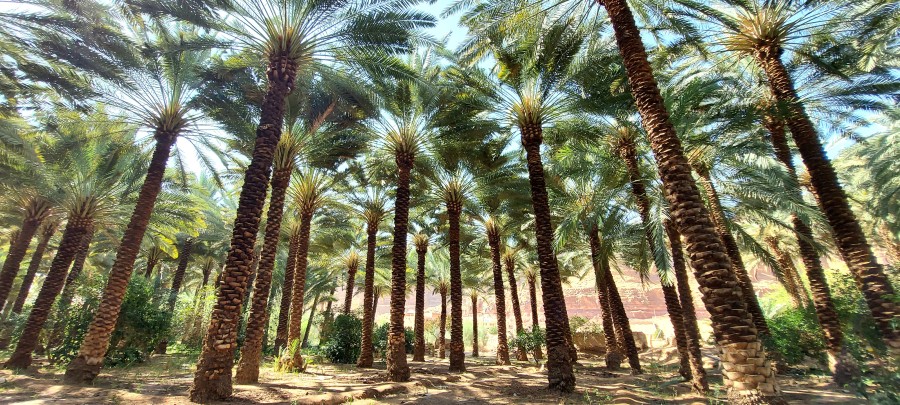
Saudi Arabia. Date palm plantation in the desert of Al Ula.
I explained to the Arabs that Indians once asked me if it’s always freezing and snowing in Poland, if polar bears go out to the streets and if everyone is drunk. I also advised that if I believed in the stereotypes that they only have a flat desert, camels, Islam and oil, there would be no point in coming to KSA to see what we had already seen. I however invested time, money and put a lot of effort into this journey; to get to know the whole of Saudia. On the other hand it is true that 95% of the territory of Saudi Arabia is covered by a desert, which is populated by about 1.6 million camels. So despite several places and landscapes that differ from the traditional image of Saudi Arabia, the stereotypes in this case are indeed true.
I also wanted to get to know the people because the culture of Saudi Arabia, although it is based on Islam and attached to the desert, it must certainly contain something else besides Islam. First of all I noticed that part of the Saudi culture is also about the way of brewing and serving Arabic coffee, usually with dates, and sometimes also in the desert under date palm trees. Saudi Arabia promotes itself as the center of the Islamic world, with regular religious pilgrimages to Mecca and Medina. Muslims want us to think that Islam is uniform, but when travelling around Muslim countries I found out without any doubt that Islam in a given country does not depend on the Koran but on the culture of each of those countries, which consists of many different things. The whole of West Asia is also very diverse and all countries require thorough exploration.
To test the reaction of Saudi Arabs regarding our talk about stereotypes I said several times that in the Arab countries of the Persian Gulf there is no difference between the people, because they are all the same Arabs who live in a hot desert and are separated with artificial borders. They didn’t agree of course and said that their mentality was different. I explained that to me as a newcomer from another civilization the most important thing was the adventure itself and to get to know Saudi Arabia, and if the stereotypes turn out to be true I had no problem with that. The adventure and most realistic experiences are most important. I also told Saudis to not to be angry and not to be surprised if Europeans think that all Arabs are the same. I asked if they thought if there was a significant difference between Poles, Czechs, Germans, Canadians and other people from the white Christian civilization, or we are more or less the same? Smiles appeared on the faces of Arabs, and then silence…..
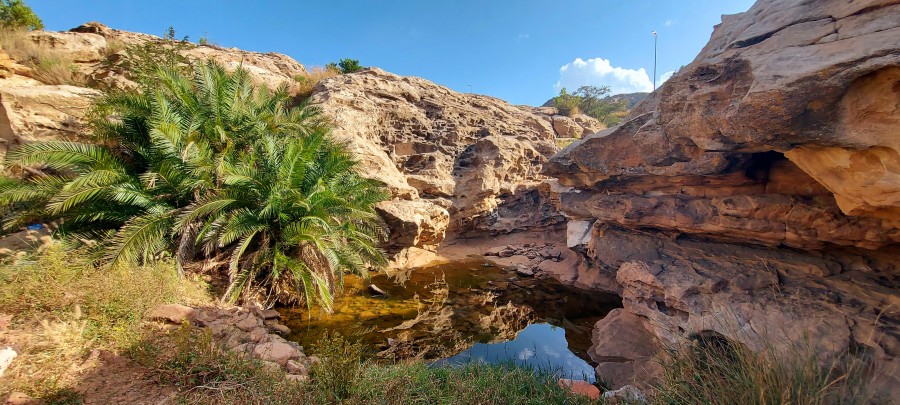
Yes, this is also Saudi Arabia. I was in Al Habalah, in the desert where there is a spectacular cliff with a precipice, interesting rock formations, a waterfall and these kinds of water reservoirs with vegetation.
To sum up: ‘desert, camels, Islam and oil’ – yes of course, but there are also things the world doesn’t know because it is not interested. Stereotypes work both ways.
Saudi Arabia – experiences with people
I have finally realized my great travel ambition. I organized a trip to the selected countries of Persian Gulf, the center of which was Saudi Arabia. My beginnings in KSA were not easy because Saudia is a very unpopular destination, people are not prepared to welcome tourists and no one waits for them or offers anything. There are countries like Nepal, Thailand or Indonesia where a traveller doesn’t even have to think too much because local people think for him. Of course this varies but those countries are much easier. In Saudi I had to earn every adventure on my own. I had to organize transport, hotels and find my own way. I also often hitchhiked and slept in a tent in the desert where it was not only hard but also cold at night and hot in the morning. In addition, no one spoke English and it was expensive and very hot, which only increased the effort of this trip. From the first day I knew that if I was to fulfill the plan of my trip to Saudi, this country would be a big challenge.
Fortunately people were helpful, and often incredibly helpful and hospitable, what made it a little easier and nicer despite the burden of my journey and lack of communication. Many times I became convinced of the great kindness of the Saudis. As I was walking alone through the desert along the road a woman stopped her car and gave me an orange. Others gave me rides and water many times, which in Arabian desert is a form of offering life. I got the impression that people were happy that I came to them and they wanted to present themselves in the best way. I often felt like a very rare animal species that Arabs offer water, tea and give dates. I personally didn’t see anyone from Europe until I visited the popular Al Ula and then Riyadh, and not many too. Once it even happened to me that an Arab stopped the car, he got out, took a picture with me, got back into the car and drove away. People also recorded me sometimes.
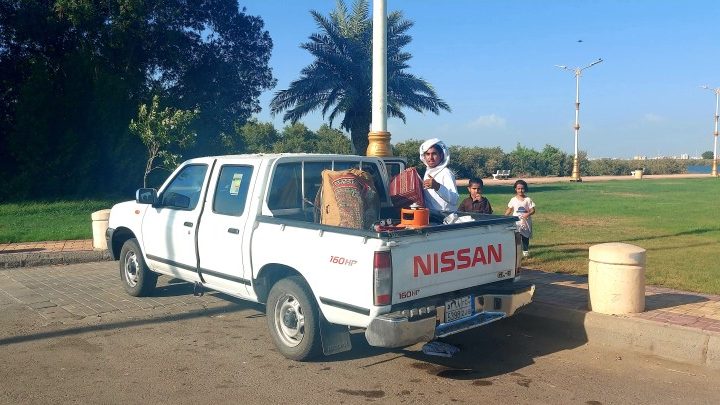
Saudi family in hot Jizan. Kind people. They invited me to their picnic for about 20 minutes. They allowed the weary traveler to sit on their carpet and gave him tea. We spoke via Google translate and then they said ‘bye bye’. Thank you.
Hospitality and giving even a little something to a newcomer from Europe, has however its roots in Islam. I heard many times that this was the nature of their religion, because I am a guest in their country. I got the impression that some Saudis gave me coffee because they wanted to do another good deed on the way to paradise; although sometimes they also did it naturally.
In Saudi Arabia however it was nicer than in Pakistan, because in Pakistan also a group of Muslims sat with me at the table and one of them paid for my tea because I was a guest in his country. However, after a while I received a chilling warning that: ‘I will burn in hell because I was not a Muslim’. In Saudi it was more subtle because there they only gave me a solid lecture and offered Islam as the only right way.
(I have so many amazing stories from my travels that someone who spent their whole life only in Western civilization, is in my opinion not only on a different worldview level but also on a metaphysical level.)
As for doing good deeds and easing the traveller’s toil, there are quotes from the Prophet Mohamed:
“He who seriously considered doing a good deed but did not do it, will have one good deed on record.”
Well, that’s very nice and I admit that Mohamed put it nicely, but he himself commited a lot of terrible crimes, so I guess bad deeds are also recorded in eternity. This kind of attitude is called hypocrisy: ‘Always be good, but I’ll be bad when it’s in my business’. In my opinion Mohamed represented precisely such an attitude. The fact is however that Saudis helped me many times and showed hospitality and kindness beyond my expectations, regardless of whether the reason for their behavior was religious or simply out of good character.
I’m not going to bear false witness against the Saudis in order to have an argument against the harmful agenda of multi-‘culturalism’!!! I judge good people well, regardless of their origin or culture. The only problem is that many people can’t digest the truth when I judge someone badly.
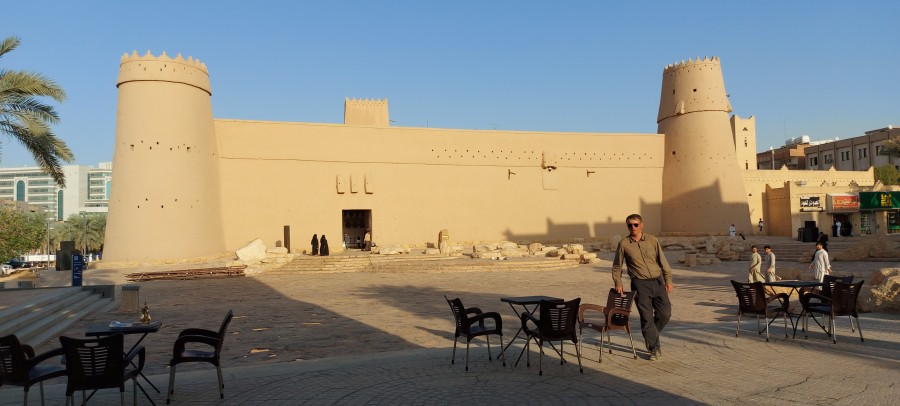
Masmak Fortress, Riyadh, Saudi Arabia. Masmak Fortress and the surrounding bazaar are in my opinion the best place in Riyadh. In this ancient place I got to know the history of Saudi and technology of making Arabic coffee.
“A guest at home is a gift from Allah.”
Yes, I feel better already but the same prophet also commanded Muslims to expand the influence of Islam and kill infidels. Islam is therefore a religion of two faces: ‘In a Muslim country let’s welcome the guest peacefully and offer him help, but if the same guest does not want Islam in his country, then he must be convinced by force to accept Islam in his country too.’ That’s how I understand it, and there is plenty of evidence to support it. I have taken up the topic of Islam many times in my numerous publications, as for example in the article: “Al Takiya-the Muslim Philosophy of Deception“. Still, I have good opinion about Saudis because they treated me well and I thank them for it sincerely. This is the most important. However, studying Islam more and more deeply I see its good and dark sides.
I set myself a goal to get to know Saudi Arabia as well as possible, and not just to go there for 12 days and show off that I‘ve been there because I have a visa. So did everyone else I met but not me. I am an ambitious traveller, not an ‘exotic visa collector’. Summing up this subchapter I have good opinion about people of Saudi Arabia, although there is also another side to this. When I talked to a Saudi man I asked him how it was possible that Indians in India tried to deceive me at every turn and were very pushy and in Saudi they behave honestly. How is it possible that in Egypt Arabs are insistent towards white women and are also generally pushy, and in Saudi they are calm. The Saudi Arab replied that it was because of the tough law. One offense and they’re out. There is no political correctness in Saudi. Personally I saw how at the sight of the police about 30 Egyptians ran away in panic.
In England they would give them benefits and apologize, and crimes are swept under the carpet so they don’t get offended. It really is like that! The West likes to criticize Saudi Arabia but I think there are some things the corrupt West could learn from Saudi too.
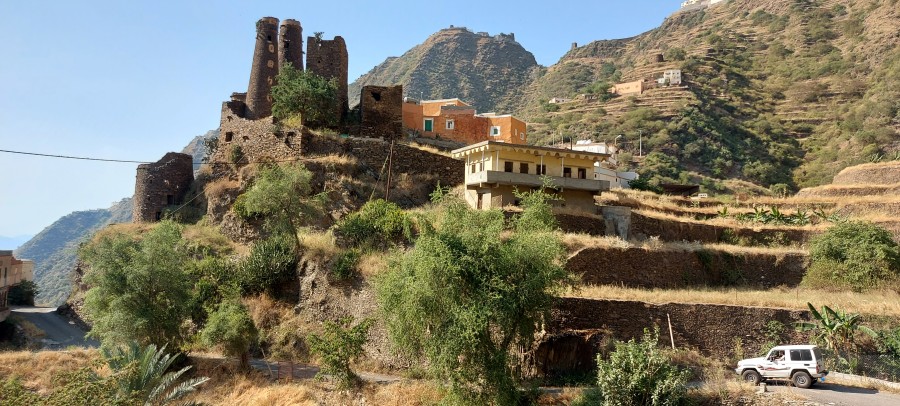
During my mountain trip to Bani Malek, near Yanfa. (I doubt anyone got there.)
My adventurous journey through Saudi Arabia
Soon I found out that apart from the desert Saudi Arabia also has picturesque valleys and spectacular mountains similar to those in Utah in the USA. Saudia also has ancient tombs and old desert-coloured forts, some pretty beaches, old towns and interesting traditional bazaars. In Saudia I also saw banana plantations and even waterfalls. Besides, different regions of Saudi have their own local cultures and people live a little differently.
I started my journey in Jeddah, which I treat as the cultural capital of Saudi Arabia. Jeddah turned out to be a great experience for me, probably because it was my first experience of Saudi Arabia. There I saw a very interesting historic Old Town with a traditional Arab market, as well as a nice promenade by the sea and a very impressive fish market. I quickly noticed that there were plenty of mosques in Saudi, not only in cities but also in places where I didn’t expect them. Regularly, five times a day people listen to prayers from loud megaphones mounted on minarets and in many other places, such as the fish market. Islam in Saudi doesn’t leave people even for a single step.
Heading south from Jeddah I went among other places to the city of Taif where there was a very nice traditional Arab market and a nice mosque. In Taif I was just getting to know people and there my journey was starting to gain momentum. Then I went through the mountains to Thee Ain which captivated me with its beauty, both architectural and natural. Whilst there I saw an ancient town built on a high rock and surrounded by banana plantations. There were also waterfalls and unfortunately herds of stupid baboons getting on my nerves.
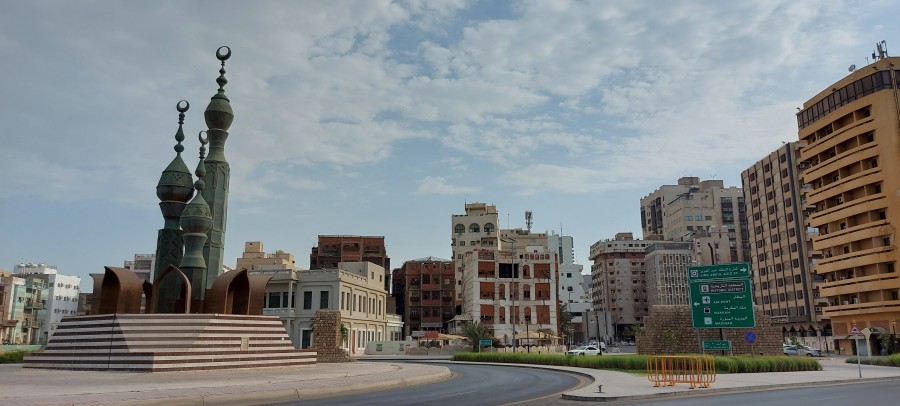
Jeddah, Old City. Saudi Arabia. Please pay attention to the road sign directing to Mecca and Medina.
From the city of Abha located in the Aris Mountains I drove through the highest peak of KSA Jebel Sooda to the cultural town of Rijal Alma. From Abha, in the vicinity of Khamis Mushait I also visited a few other cultural villages such as Al Yanfa, where I saw old villages, fields and goats and sheep shepherds. There was also an old town on a high rock, which was extremely attractive historically and architecturally. I understood then that Saudi Arabia is not only about Islam, desert and camels.
I also really liked Wadi Lajab; a red canyon crossed by streams. There were also natural pools to which I jumped into by throwing myself from the rope, and waterfalls. Then I spent the night on a Saudi farm where I had a real experience of the Saudi culture of the south. I got to know herbs, I ate coffee straight from the bush and ran in the mountains. It was there that I first learned the art of brewing and serving Arabic coffee and the strong connection that people had with their desert land. Culture is of great importance to them.
At the end of my ‘southern trip’ I went to the city of Jazan where among other things I saw an attractive fort and a cultural village. Jazan was also my base for trips to the mountains, to Fayfa and Bani Malek, as well as to the Farasan island, where I spent a few days. In Farasan I swam in the Red Sea, I saw mangrove forests and wild camels roaming the desert. In Farasan they served great fish straight from the sea. I bought them directly from the fishermen and then took them to a cook at the fish market.
North of Jeddah first I went to the holy city of islam: Medina, which is a popular destination for religious pilgrimages. I think it was a very interesting experience because I was in the heart of Islam. I had the opportunity to meet Muslims from many parts of the world during the most important and culturally emotional moments of their lives. Medina was truly unique. Too bad I couldn’t go to Mecca. Most people welcomed me warmly but many approached me with distrust and wanted to get rid of me because in their opinion Medina was a wrong place for me.
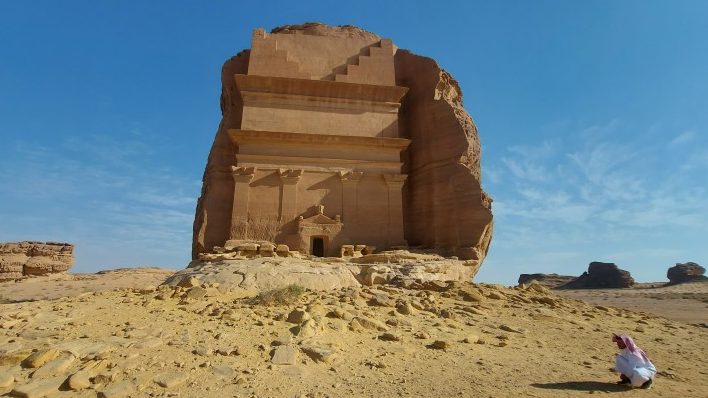
Hegra and the tomb of Mada’in Salih. Al Ula, Saudi Arabia.
Another important place was Al Ula which is undoubtedly the most popular tourist destination in Saudi Arabia without connection to Islam. Al Ula is a desert area that amazes with its natural beauty and historical wealth. In Al Ula there is a very pleasant desert old town, which is currently being modernized as it is a proof of how desert people lived many centuries ago. In Al Ula there are also impressively shaped mountains and plantations of dates and oranges, although I saw that in the hot desert under the umbrella of date palm trees Arabs also grew other vegetables and fruits. In the shade of palm trees you can also swing on a hammock.
Al Ula has many great attractions. There is for example Hegra with its ancient tombs carved in the rocks, and which are a reminder of the Nabataean civilization. Here I return with my memories to Petra in Jordan, which was a Nabatean city and in my opinion is today one of the wonders of the world. An interesting trip from Al Ula was also a visit to the Elephant Rock. My time in the desert was beautiful but hard because I slept in a tent among palm trees. Living in the desert is a hard challenge but I had to do it because hotels in Al Ula were very expensive and I was going to travel for a long time in expensive countries. Al Ula is in my opinion a must stop in Saudi Arabia.
From the point of view of natural beauty the Al Disah valley was a very picturesque place in Saudi. It is quite a narrow valley surrounded by high red mountains. A stream flows through the middle and tall grasses grow within, and I was also lucky enough to see local herders with their goats and camels. As soon as I arrived the Arabs who had a picnic there under date palm trees offered me tea. In Al Disah I spent the night in a tent. The whole of Al Disah and the area around it is a combination of a picturesque desert with attractive mountains. As usual in Saudi the only problem is getting to all those wonderful places.
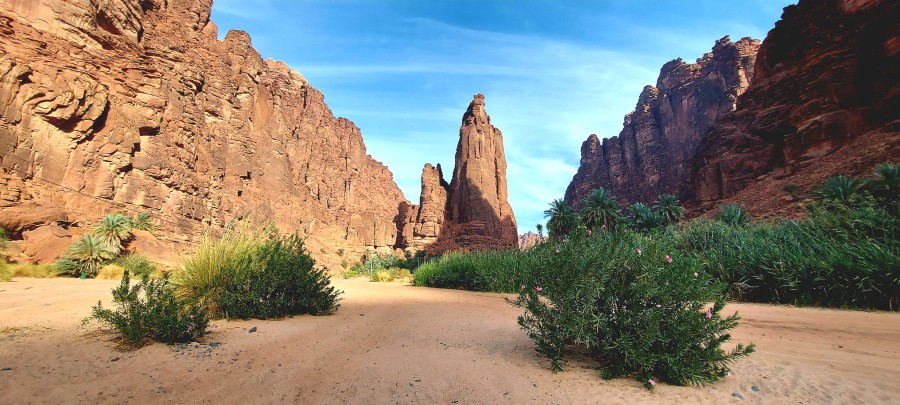
One of the most beautiful places in Saudi Arabia; Al Disah valley.
The capital of Saudi: Riyadh was very large, noisy and dirty. The traffic was a nightmare but fortunately there was something interesting there as well. In my opinion the best place for travellers in Riyadh is the Masmak fortress built in the colour of the desert and the nearby Souq Al Zal Arabic bazaar. In front of Masmak Fortress there is also Alsafat Square which serves as the Execution Ground. Many people were interested in me. Even Blacks invited me for a coffee to learn something about Europe. In Riyadh there is also one of the symbols of Saudi Arabia, the famous Kingdom Tower. This is however a playground for the rich, not for me, but I made it to the top anyway.
I however liked my adventures outside of Riyadh the most. I went on a desert expedition to see the famous cliff called the Edge of the World…..which turned out to be a difficult challenge for me. I also went to the red sand dunes where I raced through the dunes on an off-road vehicle, and then I was on a white camel farm. I spent the night in a large tent in the desert. It was great.
The last part of my trip to Saudi was the Eastern Province, to the cities of Dammam and Al Khobar, as well as several surrounding places. I walked along the seaside promenades, I bathed in the Persian Gulf and from there I went to Bahrain via the King Fahad Causeway. After returning to Saudi I went north to the city of Khafji, from where I got to Kuwait. In my opinion in Khafji there is the most beautiful beach in the whole of Saudi, which unfortunately is very far away from the still unbeaten tourist trail. Saudia is rarely visited at all, and only those who went to Kuwait visited Khafji. I did of course… and I had very successful adventures there.
True to the title of this article my journey was full of passion but it also required dedication, strength of character, ability to take risks and make the right decisions, as well as making a few sacrifices. Despite a few setbacks I fulfilled the plan of my trip even better than I planned. ‘Veni, Vidi, Vici’.
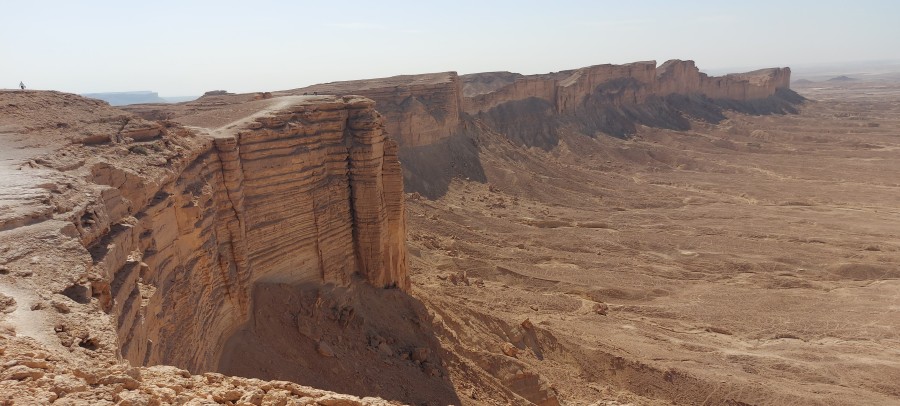
The trip to the Edge of the World was one of the hardest but the views were beautiful. How do we know we’ve reached the Edge of the World? It’s easy. We go through a flat desert and then there is a steep cliff and ‘the world ends’. So where did this cliff come from? Well, thousands of years ago there was a sea below that had already dried up. This is how the Edge of the World was created.
Things that bothered me in Saudi Arabia
Well, at the very beginning it could be twice colder and twice cheaper. Transportation was problematic. Unfortunately there is no public transport to most places that are very attractive to tourists because everyone has cars, and tourism apart from minor exceptions does not exist. It is fortunate that in crowded Riyadh they are building a subway, but this is little consolation for travellers.
From the religious side I don’t agree that women must cover their faces, and I said that to Saudi men many times. I supported this by saying that there isn’t a single word in the Koran that in Islam a woman should cover her face. Women in Islam should only cover their heads and body shape. The Arabs of course agreed with me, so the only reason why women cover their faces is because men are jealous and they treat them as their property. On that they also agreed with me, arguing that this was their custom. I am certainly not a feminist and I consider this trend to be a harmful ideology to men, women and children, but I believe that women should have their faces uncovered. I didn’t see this in Bahrain and Kuwait, so it is a Saudi custom.
I think that great weakness of Saudis and the millions of immigrants living in Saudi Arabia was lack of knowledge of the English language, and to such a hopeless degree that I lost my patience several times. It’s a pity because better communication would give us a better chance to get to know and understand each other. I admit however that they are learning. The best English speakers I met in the Eastern Province, near the border with Bahrain. (Actually, I was supposed to go to Saudi once to teach English and I already started talking to them but it turned out to be the wrong time for me. Maybe someday, but how could I stand that heat?)
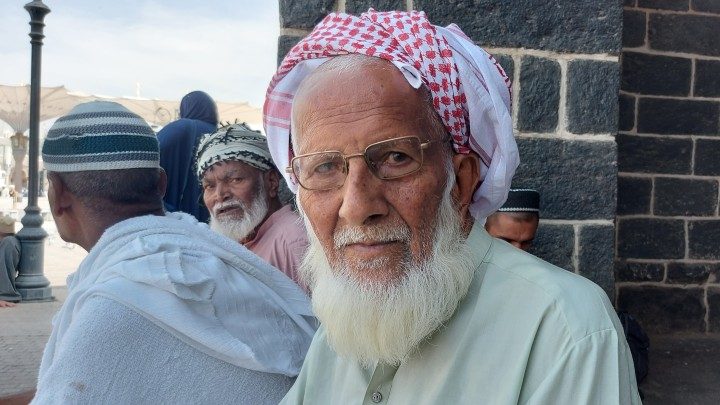
Old Saudi man. Medina, Saudi Arabia. Contacts with people were a very important part of my trip around the Arabian Peninsula.
The unpleasant problem are piles of rubbish that are present throughout Saudi Arabia, including very attractive tourist places. People are not trained how to use rubbish bins, they throw garbage where they can and also push it into smaller crevices. I can say without a doubt that all the nations living in Saudi Arabia are messy people who pollute the country they live in. When it comes to personal hygiene it is good, especially in such a hot climate, but they litter a lot around them. It’s so bad that in order to take pictures of a nice landscape I often had to point the camera in such a way that there wasn’t so much garbage in the picture, and sometimes I had to remove some garbage before taking the picture. Cleaners, mainly from Bangladesh collect rubbish and take it somewhere, but it’s not enough.
I saw whole fields covered with garbage in the beautiful Wadi Lajab canyon, in the red sand dunes about 60 km outside of Riyadh, in the desert near the cliff with a waterfall in Al Habalah, on the highest mountain trail in Saudi Arabia Jebel Sooda, in a few cultural villages, in cities of course, and practically everywhere where there were people. It was not as bad as in India where next to slums and human settlements on garbage dumps there are also thousands of opportunistic dumps on the river banks. Saudi Arabia is unfortunately moving that direction.
Saudi Arabia has a lot of ambitious architectural projects. The Saudis are building modern transport infrastructure, attractive cities, skyscrapers, subway in Riyadh, and even NEOM the city of the future for about $1 trillion. How is it possible that the government that has such huge revenues from oil and implements such ambitious projects tolerates vast fields of rubbish? It is very bad and that’s why I suggest Mohamed bin Salman to build less roads and less skyscrapers and clean up Saudia instead. (I’m going to send this article to the Saudi Embassy.)
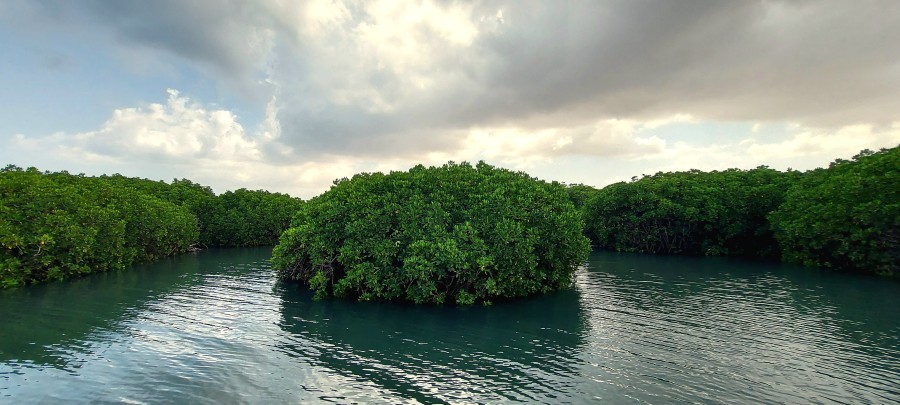
Unbelievable but I guarantee this is also Saudi Arabia. In a country covered in 95% by deserts there are very few places of this type, but they also exist. In the picture: mangrove forests on the island of Farasan, near Yemen. I saw pelicans there! (I will add that there are different types of mangrove forests. The ones in Saudi were different than the ones I had seen in Brunei and Thailand before.)
When I was in Wadi Lajab canyon I saw that an Arab boy threw a bottle on a rock, so I picked it up and gave it to him. But he threw it out anyway and his father just laughed. When I was in Khamis Mushait city I saw how Bangladeshi cleaners were taking out piles of rubbish from cracks in the streets and Indians were still throwing rubbish next to it. So I went for a kebab and saw a father and son there. When the boy threw the kebab packaging onto the street I asked him if he could throw it to the bin. His father surprisingly spoke English and replied that there was no problem because in Saudi Arabia it was a common custom. Well, culture cannot be bought for money.
Referring to the culture, I really didn’t like that the Saudis ate with their hands. They don’t use cutlery, explaining that this is their (disgusting) Saudi habit. They not only eat chicken with their hands but also rice and all other foods, like in India. Sometimes I got a plastic spoon but that was all I could hope for. Saudis – people who can afford golden forks and knives eat with their hands and lick their fingers. In addition, in most eateries there are no tables because they eat on platforms covered with carpets.
In Saudi I really didn’t like some restrictions which showed me that a country so rich in oil doesn’t care about tourism. When driving north towards the border with Jordan I wanted to go to the shipwreck beach but the road was closed. The soldier informed me through an electronic translator that a roundabout road was open, so instead of driving 30km I would have had to drive 200km. I quit.
I was passing by the ‘Neom Experience Center’. It is a building where according to the information one can learn about the plans for building the city of the future: NEOM. It is true that in theory that center was open but first I would have had to send an application to the appropriate office far away from there, and then wait a long time for an answer. Bureaucracy and making life difficult for travellers is a specialty of Saudi Arabia.
Saudi’s highest peak Jebel Sooda was also closed. I couldn’t climb because there was a cycling competition below. What a stupid excuse! So I followed a mountain trail filled with garbage but after some time I was thrown out by a policeman for ‘safety reasons’.
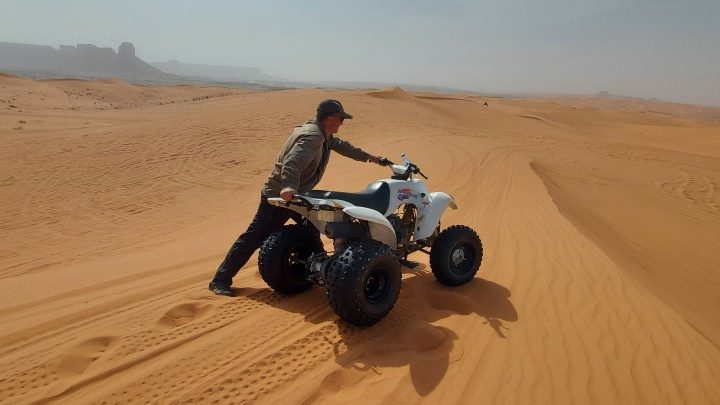
About 64 km beyond Riyadh are the Red Sand Dunes. I rode there in the dunes on an off-road vehicle, I rode a camel and spent the night in a large tent with Arabs. This is exactly the Saudi Arabia we imagine. That place was very adventurous and gave me a lot of pleasure.
Perhaps the most incomprehensible was what they did to us during our trips to the ancient Nabataean ‘cities’ in the desert near Al Ula. I went on a trip to the desert to see 2000 year old rock formations, petroglyphs and spectacular tombs in places like De Dan and Hegra. First of all there was only 15 minutes for each object and from such a distance that binoculars would be useful. I was lucky anyway because I saw everything, although not as I wanted. The previous day the Saudis had closed the largest and most beautiful tomb of Mada’in Salih!!! I told the Arabs in a cold manner that they are brazen and that a traveller needs a whole day to see the whole area at his own pace, i.e. tombs, desert and the nature around. The Italian guide who was showing her Italians around Al Ula had an argument with the Arabs. My advice: until this changes go to Jordan to see Petra. You can be there as long as your soul desires, it’s cheaper and much better.
Saudia is probably trying to prove to the world and to itself how technologically advanced it is, and to such an absurdity that in order to enter a garden in Riyadh first you need to download an application on your phone. Sometimes the simplest solutions such as paper ticket with a nice photo would be the best and least stressful. I hope Mohamed bin Salman will read this article. Anyway, the government tourism office of Saudi Arabia asked me what I thought about their country.
Summary
If this article interested my readers I guarantee that the next ones will be even more interesting because they will be fuller and will contain practical information. I would like to point out that when reading my travel memories someone might get the impression that I was on vacation, but it was not a vacation. It was a hard desert expedition during which I had to fight adversities every day, I had to organize transport, try to communicate with people who didn’t speak English, and it was expensive and very hot. Several times I ran out of water in the desert, several times I got cold sleeping in the desert and I had to drag my luggage everywhere. It was not a luxury trip and the Arabian Peninsula is a very demanding destination. Also, I was taken to a hospital two times.
Sometimes when I tell people where I’ve been, they often say that: ‘I’m lucky’ or ‘I’m a lucky man’ because I went there, and they are so poor because they didn’t. I feel very misunderstood and I must admit that this kind of reaction annoys me. I don’t go to all those countries thanks to magic but because I make such decisions and I’m not afraid to put them into practice. While in those countries I don’t have servants or sponsors. I have to organize everything by myself and everything has its price. None of my travels has absolutely anything to do with luck! I answer this question in more detail in my article: ‘Is travel only for the rich’. The journey begins with making a decision, which in my opinion only a few people can make.
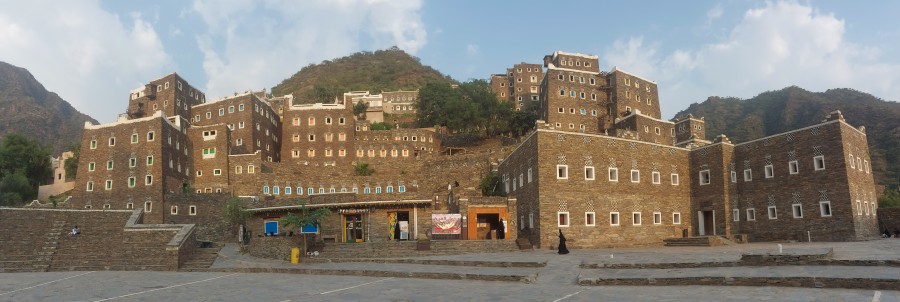
Rijal Alma; Saudi Arabia’s ancient cultural village. The starting point is the city of Abha. On the way stop at the top of Jebel Sooda where you can fight some baboons. In my opinion Rijal Alma (pictured) is of great cultural and historical value.
━━━━━━━━┓ ✠ ┏━━━━━━━━
I hope that in my first article about Saudi Arabia I managed to encourage people to discover the world. Saudia is a new and unknown destination; though not for me. I believe that I’ve helped to consider organizing expeditions not only to the countries of thousands of well-trodden trails, but also to those that have always been avoided for some reason. The world take turns in being beautiful and tragic, people are often very interesting, and travel experience itself stays with us forever. It is this beautiful, interesting, intellectually enriching diversity that can be preserved only through tight borders and acceptance of other nations as they are.



